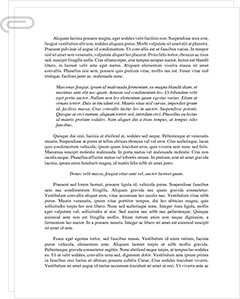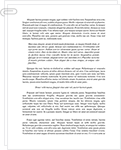 Study Document
Study Document
Factors to Consider in Developing a Multigenerational Workplace Research Paper
Pages:9 (2561 words)
Sources:7
Document Type:Research Paper
Document:#95975096
Creating a Cohesive Environment for the Multigenerational Workforce1. IntroductionFor the first time in human history, as many as five generations are represented in the workplace today. Moreover, there are going to be some other significant changes in the demographic composition of the nations workforce in the years to come, so it is vitally important for human resource practitioners to pursue optimal staffing solutions (Stevens, 2018).. The purpose of this paper is to provide a review of the relevant literature to define the current generational cohorts in the American workplace, followed by an analysis concerning how intergenerational differences affect workplace relationships and leadership style preferences. Finally, the paper presents a summary of the research and salient findings about creating a cohesive environment for a multigenerational workforce in the conclusion.2. Define the generationsThe designation of the discrete generations that follow below as well as their respective assignment of age ranges is credited to William Strauss and Neil Howe where they first used the breakdown in their 1991 book, Generations: The History of America\'s Future, 1584 to 2069 (Miller & Caspra, 2017). For the purposes of this study, though, the so-called Traditionalist or Silent generation (i.e., people born before 1946) are not included in this multigenerational breakdown since they comprise an increasingly miniscule percentage of the American workforce today (Stevens, 2018).a. Baby Boomer Generation (19461964). Although the most recent estimates from the U.S. Bureau of Labor Statistics indicate that this generational cohort comprises nearly 30% of the American labor market (Stevens, 2018), this figure may have changed substantially due to the economic downturn and corresponding job losses that are attributable to the ongoing Covid-19 global pandemic. At present, the number of Baby Boomers, currently around 74 million, is projected to decline precipitously to about 27 million by mid-21st century (Bialik & Fry, 2019). In addition, the growing legions of Baby Boomers that have already retired (many of them earlier than they planned due to the Covid-19 pandemic) or plan on retiring in the next few years will place enormous pressure on the countrys Social Security network of support. In this regard, Rodriguez and Green (2009) emphasize that, As boomers begin to collect Social Security, pensions, and other benefits, changes to both public and private retirement systems may occur, such as raising the ages of eligibility, creating flexible pension plans and altering employment practices (p. 68).b. Generation X (19651980): The current estimates of the Generation X cohort indicate that there are about 72 million people in the United States who were born during this period, but this figure will decline to approximately 50 million workers by 2050 (Bialik & Fry, 2019). In many ways, members of Generation X have been caught in the middle between two more influential generational cohorts, but their place in the intergenerational schemata means they have survived a social and political crucible that gives them more resilience compared to many members of other generations . For instance, according to Cohen (2017), Caught between vast, self-regarding waves of boomers and millennials, Generation X is steeped in irony, detachment, and a sense of dread. One of their rank argues that this attitude makes it the best suited to preserve American tradition in these dark new days (para. 2).c. Generation Y/Millennials (19812000): Estimated at around 73 million people, this generational cohort overtook Baby Boomers to become the largest living adult generation in the United States in 2019 (Bialik & Fry, 2019). This trend is expected to continue to accelerate these differences as immigrants continue to increase the numbers of this generational cohort, while also driving greater gender, ethnic and racial diversity in the…
…acquired through the school of hard knocks and others from prestigious graduate schools. As a result, unlike coaching, members of each generational cohort can serve as mentors in some capacity for members of other generations. Regardless of its source, though, the importance of knowledge for organizations of all sizes and types is well documented, and there is a growing consensus among organizational behaviorists that one of the only certain ways of achieving and sustaining a competitive advantage is through knowledge acquisition and administration. In this regard, Stevens (2018) points out that, Learning and transferring knowledge within an organization is essential to the future success of the organization. As such it has become imperative for managers to enhance organizational competence in the development of knowledge capture and transfer (p. 220). This guidance means that it is also vitally important to memorialize tacit knowledge while it is still available and to ensure that it is disseminated to appropriate employees that can benefit from the lessons learned in the past.6. ConclusionThe research was consistent in showing that the demographic makeup on the American workforce has changed in fundamental ways in recent years, and even more pronounced changes are anticipated at least until mid-21st century. Some of the more timely and relevant findings that emerged from the research included the fact that the combination of declining birthrates and a rapidly retired Baby Boomer generation is creating a gap in the current workforce which is projected to become even more pronounced by 2050. Although it would be disingenuous to conclude that each of the generational cohorts that were originally identified by Strauss and Howe in 1991 represents a discrete group with universal attributes, the findings did underscore the need to take the respective general preferences for each generational cohort with respect to leadership style into account…
Related Documents
 Study Document
Study Document
Multigenerational Issues in Leadership
multigenerational issues of leadership in the workplace. The discussion explores the differences between the traditionalist generation, baby boomers, Generation X and Generation Y the discussion also focuses on how the differences between these generations have affected the nursing shortage that America is now faced with. Our discussion examined the nursing shortage which has been caused by the ageing baby boom population and the lack of new recruits. It seems evident
 Study Document
Study Document
The Pedagogy of Emotional Intelligence Ei in the Workplace for Generations Baby Boomers...
Multigenerational Workforce Motivation Leadership Style Talent management and human resource management personnel have, been aware of the commercial value of creating and leveraging an all-encompassing, diverse workforce for several years. Recruitment and employee retention programs have focused on gender, ethnicity, race, recruitment and career development of veterans, disabled persons, etc. One can observe increased demands among corporate personnel, to include multigenerational diversity in their organizations. Talent and human resource managers have
 Study Document
Study Document
Using Emotional Intelligence in the Workplace
One of the most important and essential qualities of leadership needed in today's multigenerational business world is Emotional Intelligence (EI). EI is a "people smart" type of intelligence -- it enables an individual to read a person and provide the right kind of emotional feedback and/or responses to that person's needs. Leaders who demonstrate strong emotional intelligence are able to
 Study Document
Study Document
Diversity and the Business Culture
Changing Diversity and the Workplace
Introduction
Changing diversity is a major trend affecting the U.S. workforce and the demographics of virtually every organization. Demographics are destiny, as the common saying goes (Wolfe, 2017), and in the U.S. the future is being determined right now: families are shrinking, the population is graying, and the U.S. workforce is becoming more diverse (Buckley & Bachman, 2017). This diversity includes increases in women in
 Study Document
Study Document
Learning Styles and College Students
Community Colleges in America In 1983 and 1984, a dozen major reports on the United States' schools were published. All stressed the need for "excellence" in education. These reports are the subject of: Excellence in Education: Perspectives on Policy and Practice. The reports pertaining to higher education were published by The BusinessHigher Education Forum, and saw higher education as "unable to train skilled managers and technicians that they believed industry needed."
 Study Document
Study Document
Effect of Forgiveness on Health
Forgiveness on human health. In its simplest form, the purpose of the study is to evaluate human psychological stress that might constitute a risk factor for heart disease. Further, the study will also evaluate the impact of forgiveness on heart disease. However, such a simple dissertation clearly demands further definition. What, exactly, do we signify when we speak of heart disease? What is properly considered as forgiveness? What impact does




